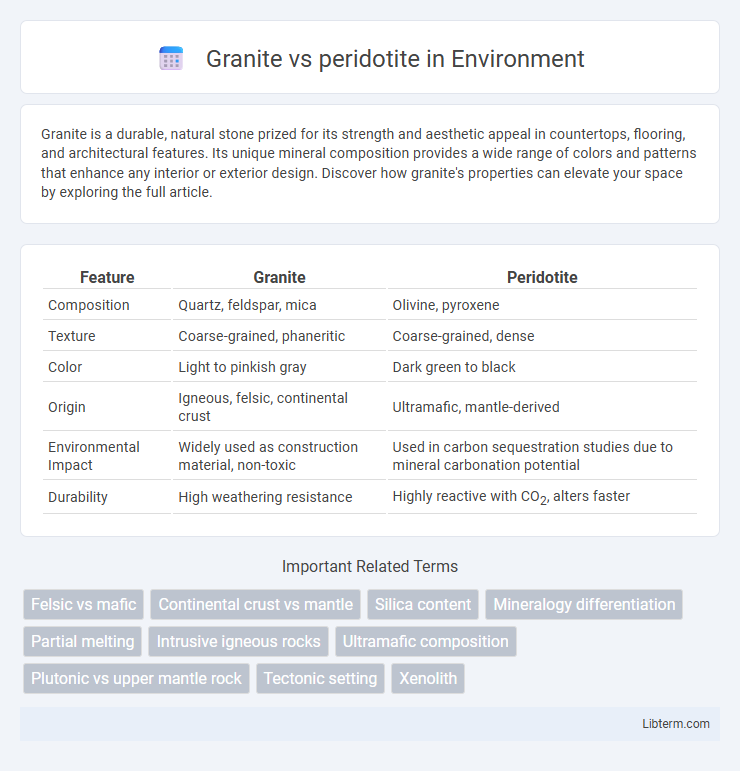Granite is a durable, natural stone prized for its strength and aesthetic appeal in countertops, flooring, and architectural features. Its unique mineral composition provides a wide range of colors and patterns that enhance any interior or exterior design. Discover how granite's properties can elevate your space by exploring the full article.
Table of Comparison
| Feature | Granite | Peridotite |
|---|---|---|
| Composition | Quartz, feldspar, mica | Olivine, pyroxene |
| Texture | Coarse-grained, phaneritic | Coarse-grained, dense |
| Color | Light to pinkish gray | Dark green to black |
| Origin | Igneous, felsic, continental crust | Ultramafic, mantle-derived |
| Environmental Impact | Widely used as construction material, non-toxic | Used in carbon sequestration studies due to mineral carbonation potential |
| Durability | High weathering resistance | Highly reactive with CO2, alters faster |
Introduction to Granite and Peridotite
Granite is a coarse-grained, felsic intrusive igneous rock primarily composed of quartz, feldspar, and mica, commonly found in continental crust. Peridotite is a dense, ultramafic igneous rock dominated by olivine and pyroxene, constituting a major component of the Earth's mantle. Both rocks differ significantly in mineral composition, texture, and formation environment, influencing their respective geologic roles and surface expressions.
Geological Origins and Formation
Granite forms from the slow crystallization of magma beneath the Earth's surface, characterized by its high silica content and predominantly quartz and feldspar minerals. Peridotite originates in the upper mantle and consists mainly of olivine and pyroxene, representing a source rock for basaltic magmas during mantle melting processes. The contrasting geological origins highlight granite as an intrusive igneous rock formed in continental crust settings, while peridotite is an ultramafic rock linked to mantle dynamics and tectonic plate interactions.
Mineral Composition Differences
Granite primarily consists of quartz, feldspar, and mica, exhibiting a high silica content of around 70%, which gives it a lighter color and coarse-grained texture. Peridotite is dominated by olivine and pyroxene minerals, with low silica content below 45%, resulting in a denser, darker, and coarse-grained ultramafic rock. The stark contrast in mineral composition between granite's felsic minerals and peridotite's mafic to ultramafic minerals defines their differing geological roles and physical properties.
Color, Texture, and Appearance
Granite typically exhibits a coarse-grained texture with visible interlocking crystals of quartz, feldspar, and mica, resulting in a speckled appearance ranging from white to pink or gray hues. Peridotite, in contrast, has a coarse texture dominated by olivine and pyroxenes, giving it a dark green to black coloration with a more uniform and dense appearance. While granite's light colors and granular texture make it popular for countertops and architectural use, peridotite's darker, more rugged look is often associated with mantle rocks and is less commonly used decoratively.
Physical and Mechanical Properties
Granite exhibits high compressive strength, low porosity, and excellent durability, making it ideal for construction and architectural applications. Peridotite is denser and has higher magnetic susceptibility due to its ultramafic mineral composition, with greater resistance to deformation under high pressure. While granite is more brittle and prone to fracturing, peridotite's coarse-grained, olivine-rich matrix provides superior toughness and thermal stability in geological contexts.
Occurrence and Distribution Worldwide
Granite primarily occurs in continental crust regions, with major deposits found in North America, Europe, and Asia, especially within mountain ranges like the Sierra Nevada and the Himalayas. Peridotite, predominantly present in Earth's mantle, surfaces mainly in ophiolite complexes and is distributed in tectonically active zones such as the Arabian Peninsula, the western United States, and parts of the Mediterranean. The contrasting occurrence reflects granite's formation via slow cooling of magma beneath continents and peridotite's ultramafic composition originating from deep mantle rock exposures.
Uses in Construction and Industry
Granite is widely used in construction for countertops, flooring, and exterior cladding due to its durability, aesthetic appeal, and resistance to weathering. Peridotite, rich in olivine and pyroxene, is primarily utilized in the production of refractory materials and as a source of magnesium and chromium for industrial applications. While granite is favored for architectural and decorative purposes, peridotite's role is more specialized, serving as a raw material in metallurgy and environmental engineering projects like carbon sequestration.
Weathering and Durability
Granite exhibits high durability due to its interlocking quartz, feldspar, and mica crystals, which resist chemical weathering and physical abrasion effectively. Peridotite, rich in olivine and pyroxene, weathers more rapidly through chemical alteration processes like serpentinization, making it less durable in surface environments. The slower weathering rate of granite contributes to its extensive use in construction and monuments, whereas peridotite's susceptibility limits its applications and leads to soil formation enriched in magnesium and iron.
Environmental Impact and Sustainability
Granite mining generates significant waste and requires extensive energy, causing habitat disruption and high carbon emissions, while peridotite's potential for carbon sequestration through mineral carbonation offers a sustainable advantage. The slower weathering of granite limits its ability to capture atmospheric CO2, whereas peridotite's rapid reaction with CO2 makes it an effective natural carbon sink. Sustainable extraction of peridotite can contribute to climate change mitigation, contrasting with granite's more traditional environmental footprint.
Comparative Summary: Granite vs Peridotite
Granite is a coarse-grained, felsic intrusive igneous rock composed mainly of quartz, feldspar, and mica, characterized by its light color and high silica content, typically around 70%. In contrast, peridotite is an ultramafic igneous rock predominantly made of olivine and pyroxene, dark green to black in color, with low silica content usually below 45%, making it denser and richer in magnesium and iron. Granite forms in continental crust environments, often associated with mountain-building processes, whereas peridotite originates from the Earth's mantle and is a primary source of basaltic magma.
Granite Infographic

 libterm.com
libterm.com